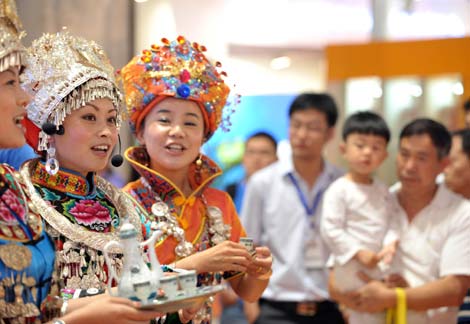|
 |
|
A folk art performance attracts visitors to the four-day 15th China Chongqing International Investment and Global Sourcing Fair, which ended on Sunday. More than 7,000 foreign enterprises from 43 countries and regions attended the fair. [Photo / Xinhua] |
Xi'an, Chengdu or Chongqing, where to invest? This will be a hard choice for foreign investors.
Undoubtedly, while rising wages and costs sap growth in the coastal and eastern regions that have led China's exports and growth during the past three decades, western regions with skilled labor are turning into magnets for global companies that are either transferring bases or adding investment in the region.
"The story of western China is appealing," said Andy Serwer, managing director of Fortune magazine.
But exactly where to go is a question for foreign companies, and it takes time to make a final decision.
In April, when South Korea-based Samsung Electronics Co Ltd, the world's leading consumer-electronics maker, announced it would make its largest investment overseas in Xi'an in Shaanxi province, the city moved into the limelight overnight.
But few people know another western city - Chongqing - was a contender before the company's final decision was made.
"While economic growth in the western region is becoming a bright spot and western cities are enhancing efforts to open up and attract foreign investment, competition among the three cities is unavoidable," said Xian Guoming, director of the Center for Transnational Studies at Nankai University.
"But it's not a big issue. They have already built up different strengths from each other."
Chongqing, for instance, is building the world's largest laptop-manufacturing base, and global leading laptop makers including HP, Acer and ASUS have plants in the city.
The initial success of the three western cities has benefited from the country's "Go West" campaign, which was launched in 2000 to address the growing inequality in economic growth between the western and eastern regions.
The policy targets six provinces (Shaanxi, Gansu, Qinghai, Sichuan, Guizhou and Yunnan), five autonomous regions (Xinjiang, Inner Mongolia, Tibet, Ningxia and Guangxi) and the municipality of Chongqing.
Western China occupies more than 70 per cent of the nation's territory and holds more than half of its mineral resources.
The cities of Chengdu, Chongqing and Xi'an have led the economic growth of China's west, and they are also in the vanguard of growth in foreign direct investment in the region.
In 2011, the GDP of the three cities - Chongqing, Xi'an and Chengdu - rose by 16.5 percent, 13.8 percent and 15.2 percent to 1 trillion yuan ($158.2 billion), 386.4 billion yuan and 685.5 billion yuan, respectively.
The figures were higher than the growth rate of 9.2 percent for the nation as a whole and 13 percent for the western region last year.
Among the three cities, Chengdu has been an early bird in absorbing FDI.
